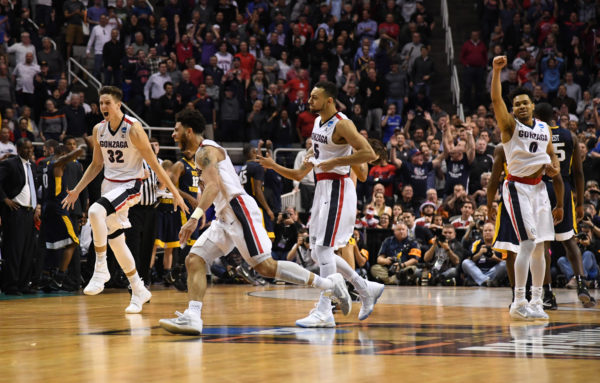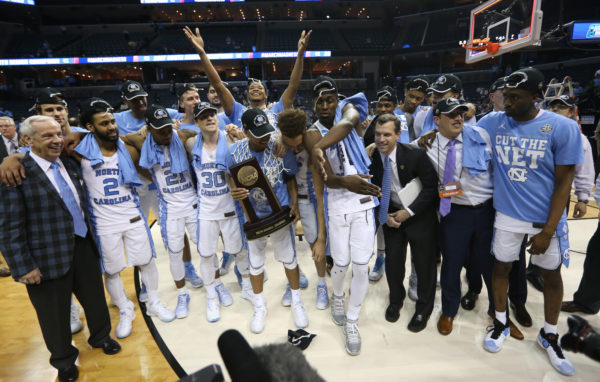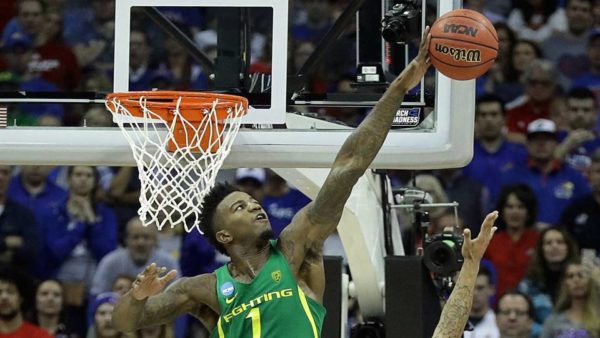Now that we’re down to the Final Four, let’s take a deep dive into each of the four remaining teams. Today: South Carolina.
How South Carolina Got Here
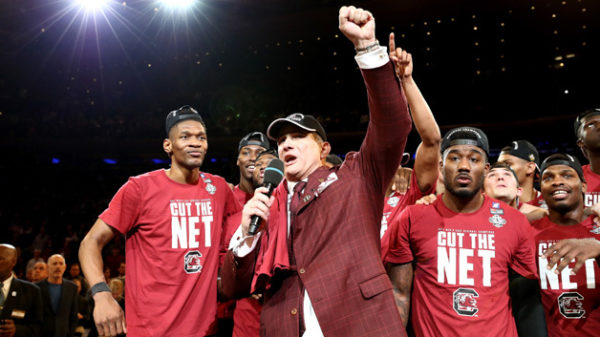
South Carolina is headed to its first Final Four ever. (Photo Credit: Elsa/Getty Images)
East Region Champions. Despite entering Selection Sunday having lost six of its previous 10 games, South Carolina was given a surprisingly-high seed (#7) in a surprisingly-favorable location: Greenville, South Carolina. The Gamecocks took full advantage, crushing #10 seed Marquette before pulling off one of the biggest upsets of the NCAA Tournament against #2 Duke, scoring 65 points in the second half en route to an 88-81 runaway victory against the National Championship favorite. In its first Sweet Sixteen since appearance since 1973, South Carolina then held #3 Baylor to a season-low 0.76 points per possession; two days later, the Gamecocks put the finishing touches on their Cinderella run by upending SEC rival #4 Florida, limiting the Gators to 0-of-14 three-pointers in the second half on their way to a seven-point triumph.
The Coach
Frank Martin. In just five short years, Martin — a former nightclub bouncer and perhaps the scariest man in college basketball — has lifted a program from the depths of irrelevance to its first Final Four in school history. And he’s done it with the same hard-nosed, defensive-minded coaching style that made him successful in his first Division I coaching stint at Kansas State (2007-12). The former Bob Huggins assistant has clear stylistic similarities to his mentor, employing an aggressive, relentless brand of basketball intent on wearing down opponents mentally and physically. In eight of his 10 years as a college head coach, Martin’s teams have ranked among the top 40 nationally in adjusted defensive efficiency. The Miami native spent 15 years coaching high school basketball in his hometown before joining Northeastern as an assistant in 2000, so his decision to take the South Carolina job in 2012 — a program with only three Sweet Sixteen appearances in its long history — was not overly surprising. Martin knows how to be patient. After missing the NCAA Tournament in his first four seasons, that patience is finally paying off.
Style
For South Carolina, success starts on the defensive end. The Gamecocks rank second nationally in adjusted defensive efficiency, fourth in defensive turnover rate, 12th in effective field goal percentage defense, and perhaps second to only West Virginia — Huggins’ group — in sheer physicality. Led by a pair of elite defenders in 6’5” Sindarius Thornwell and 6’6” PJ Dozier, South Carolina presses and traps all over the court, making it difficult for opposing ball-handlers to cross the timeline, much less comfortably run offensive sets. In the half-court, the Gamecocks aggressively extend on shooters, preferring to commit fouls over allowing open shots from the perimeter. Their length and knack for swarming to the ball (often employing a half-court trap) makes clean interior looks nearly as difficult, especially with 6’9” Chris Silva — a good per minute shot-blocker — manning the paint. They simply deny everything. Offensively, aggression remains the name of the game: South Carolina scores a whopping 23 percent of its points from the free throw line and another 50 percent from inside the arc, attack the basket at will, often off of turnovers. Having big, physical guard/forwards like Thornwell and Dozier helps.
Strengths
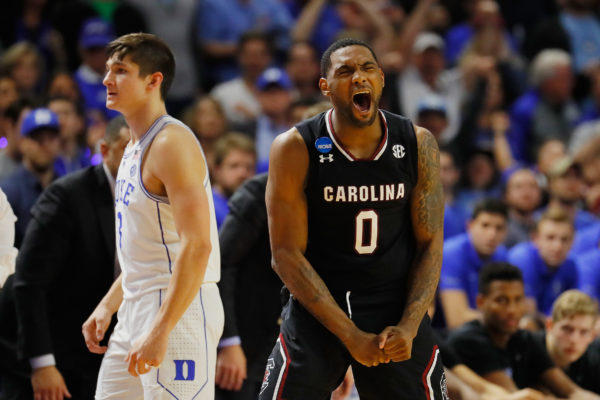
Sindarius Thornwell has been Superman for the Gamecocks this season. (Getty Images)
- Limiting three-pointers. South Carolina does an exceptional job of taking away perimeter jumpers, allowing opponents to score just 25.6 percent of their points from behind the arc. The Gamecock guards relentlessly press up on shooters, sometimes resulting in fouls, but often resulting in forced jumpers or haphazard drives late in the shot clock. Really, the same reason opponents have such a difficult time shooting three-pointers is the same reason South Carolina forces turnovers at a higher rate than all but three other teams in the country: opposing guards simply can’t breathe once they cross half-court.
- Attacking the basket. Thornwell is in a class of his own when it comes to attacking the rim. The senior ranks 13th nationally in fouls drawn per 40 minutes, a testament to his bullish aggressiveness in the lane and willingness to push the ball as far and as fast as back-peddling defenders will allow. When South Carolina forces turnovers (which is often) he and his teammates waste no time getting downcourt—the Gamecocks average just 16.6 seconds per offensive possession. They also pound the offensive glass, cleaning up misses at the third-highest rate among SEC teams. Between free throws, offensive rebounds, and plain strong drives to the hoop, South Carolina is able to sustain itself offensively despite its poor shooting numbers.
- Endurance. According to this account, South Carolina full-court presses during the majority of practices and often plays five-on-seven (advantage to the offense) in order to whip its dogged defense into shape. That grueling work ethic clearly pays off on game day. The Gamecocks are +54 in the second half during the NCAA Tournament, wearing down opposing offenses to such a degree that their offense — which, again, thrives on attacking the rim — can flourish. South Carolina’s second-half blitzes against Duke, Marquette, and Florida are shining examples. Conditioning, both mental and physical, seems to matter.
Weaknesses
- Shooting. At 47.4 percent eFG, South Carolina ranks 299th nationally in effective field goal percentage. That’s not good. Outside of Thornwell (39.4% 3FG), there really aren’t any serious outside shooting threats on the roster. Guard Duane Notice (10.2 PPG) is capable of getting hot, but he’s also very streaky. Dozier (13.8 PPG) takes a lot of shots, but he’s usually not all that efficient. If Thornwell is off and Silva isn’t going to work inside, the Gamecocks can become very stagnant very fast.
- Foul trouble. That aggressive defense has one glaring downside: free throws and foul trouble. Not only do South Carolina’s opponents score almost 27 percent of their points from the charity stripe, but several crucial Gamecock players — most notably Silva —are often forced to take a seat early. The 6’9” forward has fouled out 10 times this season, seven of which South Carolina lost. Dozier, another superb defender, also runs into similar trouble from time to time. Against talented offenses like Gonzaga, North Carolina and Oregon, free points and foul trouble could become an issue.
- One-dimensionality. It may be oversimplifying things to say that South Carolina’s success boils down merely to defense and Sindarius Thornwell, but it’s not that far from the truth. Fact is, the Gamecocks must continue dominating on defense, and the senior sensation must continue to playing at a high-level offensively in order for Martin’s team to have a chance in Phoenix. If one of those two elements slips — say, the defense sputters like it did against Arkansas in Feburary, or Thornwell struggles like he did against Alabama in the SEC Tournament — it’s hard to envision South Carolina recovering.
Go-To Scorer
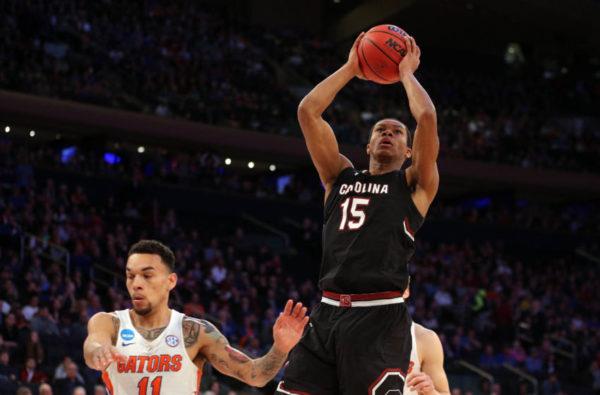
For South Carolina to succeed in Phoenix, PJ Dozier must keep performing offensively. (fansided.com)
Sindarius Thornwell (21.6 PPG, 7.2 RPG, 2.2 SPG). Before Duke’s Round of 32 loss to South Carolina, Mike Krzyzewski called Thornwell “the best, unheralded, great player in the United States.” And even that might be an understatement. The 6’5” in-state product is averaging nearly 26 points per game during NCAA Tournament play, showcasing his relentless aggression (he’s already attempted 39 free throws), shooting ability (42% 3FG over four games), and superb defensive skills. He’s also an outstanding offensive rebounder, once ripping down 10 offensive boards en route to a ridiculous 44-point, 21-rebound stat line against Alabama on February 7. Among players who have attempted 250+ free throws this season, only a handful of players boast a higher free throw percentage than the senior (83% FT). Thornwell also led the SEC in steal percentage during the regular season. There’s a reason he was the coaches’ choice for Conference Player of the Year (not to mention 7th in KenPom National Player of the Year rankings)—Thornwell is great.
X-Factor
PJ Dozier (13.8 PPG, 4.7 RPG). For better or worse, the talented sophomore takes a staggering 31 percent of his team’s shots while on the floor, which is roughly 70 percent of the time. That shot rate is higher than Thornwell’s (28.7%). When he shoots 50 percent or better from the field, South Carolina is 11-0; when he shoots under 40 percent, Martin’s team is 10-6. That seem like “picking and choosing” statistics, but it’s hard to deny that the Gamecocks’ offense is markedly better when Dozier is efficient. Silva, and bench production from players like forward Maik Kotsar (12 points vs. Florida), will also be key.
Outlook
When are we going to learn? South Carolina has entered each of its last three games as the underdog, yet won each contest by an average 11.3 points. It hadn’t scored over 1.1 points per possession since February 15 prior to Selection Sunday; in the four games since, Martin’s group has surpassed that mark three times. Tough, confident, and afraid of nobody, the Gamecocks now face their most difficult opponent yet: a Gonzaga team that boasts the nation’s most efficient defense with nearly an offense to match. Still, count South Carolina out at your own risk.





























